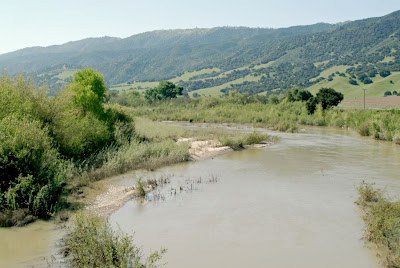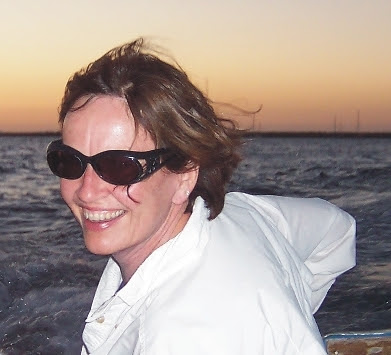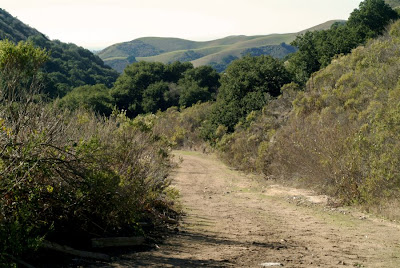Book Review: A Journey into Steinbeck's California
One of the very best books I've ever read is featured here in our Book Review this week. Published by Roaring Forties Press and authored by Susan Shillinglaw, A Journey into Steinbeck's California is a treasure. Full of gorgeous photos by Nancy Burnett, artwork of the times, photos of Steinbeck's contemporaries, and in-depth sidebars of places, people, and events, this book delves deeply into Steinbeck and California.
Chapters include:
-
Steinbeck's California: the Valley of the World
-
Salinas: a remembered symphony
-
Beyond Salinas: Salad bowl of the world
-
Moving around: a restless decade
-
Monterey Peninsula: circle of enchantment
-
Pacific Grove: the writer's retreat
-
New Monterey: water-gazers
-
Bohemian Carmel: modernism in the west
-
Los Gatos: a place to write
-
Beyond California: the lure of Mexico

Salinas River
Susan Shillinglaw is a Professor of English at San Jose State University and Scholar-in-Residence at the National Steinbeck Center in Salinas. For eighteen years, she was Director of the Center for Steinbeck Studies at SJSU, where she edited the award-winning journal Steinbeck Studies (previously The Steinbeck Newsletter), published twice yearly. She was a consultant to Harpo Productions for Oprah’s website on East of Eden and frequently consults for popular media as well as scholarly projects—most recently for a State Department-sponsored film made by a Georgian (formerly a part of the USSR) television station. In July 2009 she will co-direct for the second time a National Endowment for the Humanities Institute for high school teachers in Pacific Grove, California: “John Steinbeck, Voice of a Region, Voice for America.” (see steinbeckinstitute.org). For the Steinbeck Centennial in 2002, she co-directed an National Endowment for the Humanities Library grant with Harold Augenbraum of NYC’s Mercantile Library, creating a Centennial website and publishing two books under the grant: John Steinbeck: Centennial Reflections by American Writers and a pamphlet for libraries across the country, How to Organize a Steinbeck Book or Film Discussion Group.
Cactus in Sea of Cortez
She has published widely on Steinbeck, most recently completing an introduction to The Winter of Our Discontent for Penguin New American Library (2008). Other publications include America and Americas and Selected Nonfiction (2002) and A Journey into Steinbeck’s California (2006), a travel guide and biography examining the impact of place on Steinbeck’s vision. Currently she is completing a short biography of Steinbeck as well as a biography of his first wife, Carol Steinbeck.
Professor Shillinglaw received her B.A. in Art and English from Cornell College in Mt. Vernon, Iowa; and her M.A. and Ph.D. in American literature from the University of North Carolina, Chapel Hill. She has taught at Wake Forest University, Canisius College, The Buffalo Seminary, Santa Clara University, and, since 1984, at San Jose State University. In 2003 Cornell College recognized her as the distinguished undergraduate from her graduating class.
What an impressive CV!
We were lucky enough to sit down and talk with Susan about her book. Here's what she had to say...
WE: Please tell us about your book, A Journey into Steinbeck's California...
SS: The book is a hybrid text, part biography, part analysis and discussion of Steinbeck’s work, part social history, part travelogue. It was great fun to write and compile (selecting sites to photograph, deciding what information to “box”) The approach is holistic. I look at Steinbeck’s sense of place and how various locations in California both shaped his writing and how he, in turn, was shaped by the places he inhabited. For Steinbeck, place always concerned the intersection of human history and natural history. It was stimulating to think about how human histories and nature, cultural artifacts and social issues intersected in Steinbeck’s fiction. A novel like Cannery Row, for example, draws from Steinbeck’s interest in intertidal ecology, his love of local history, his friendship with Ed Ricketts, his stint as a war correspondent in World War II, and the local itself—where Pacific meets shore. I hope this book gives that rich sense of Steinbeck living in place. He makes readers feel and “participate” in the California landscape, and I hope that resonance is clear in this book.
WE: What led to your interest in Steinbeck's California?
SS: For 18 years I was Director of the Center for Steinbeck Studies at San Jose State University. I was given the job by a wonderful Chair of the English Department at SJSU, Lou Lewendowski. She had faith that an Americanist with no background in Steinbeck could learn to be Director of a major archive; I rose to the occasion and began learning all about John Steinbeck when I was appointed Director in 1987—with the loyal guidance of other Steinbeck critics, Louis Owens, Bob DeMott, Jack Benson. New to California (I grew up in Colorado) I started interviewed surviving friends of Steinbeck; I began a new publication, the Steinbeck Newsletter, subsequently called Steinbeck Studies; I planned a major conference on The Grapes of Wrath in 1989 (and later co-Directed 3 other major Steinbeck conferences); I started the Steinbeck award, “In the Souls of the People” with a colleague at SJSU, Ted Cady. For those 18 years, it seemed like I was simply immersed in Steinbeck. It was a delightful era; I was fortunate to know Elaine Steinbeck, the author’s widow, other family members and many friends from the era.
The book came out of years of Steinbeck lectures. I spoke to library groups (during the Centennial in 2002 I gave more than 50 lectures) and school groups, at conferences and often in other countries. Steinbeck is beloved worldwide, and I was lucky enough to travel extensively. The book is, in fact, a tribute to all those audiences who responded to my speaking about Steinbeck in California.

Susan Shillingaw
WE: What research did you do, for the book? The photos and illustrations are intriguing - can you tell us more about that?
SS: As I note above, the research was generated by my employment as Professor of English (teaching Steinbeck yearly, as I still do) and Director of the Steinbeck Center at SJSU. I also spent years researching a book on Steinbeck’s first wife, Carol Henning, which will be submitted to a publisher this year, and writing several academic articles and editing books on Steinbeck. I’ve spent hours in archives around the country, since Steinbeck’s letters and manuscripts are scattered in many major collections: at Stanford University, in his home town of Salinas, at the Pierpont Morgan Library in New York City, at Columbia University, at University of Texas, at Ball State University. I drew on this scholarly background.
To write the book, I revisited Stanford archives and Salinas archives, as well as several local archives: mine was a treasure hunt for local resources and libraries are a great source of information. Many of the period photographs came from these tiny archives that I dug through in Pacific Grove, Monterey, and Salinas.
The contemporary photographs were quite another kind of research. The superb photographer, Nancy Burnett, accompanied me on trips around Steinbeck locales. We spent a day tramping around Salinas, looking for interesting ways to photograph buildings. We strolled through the hills trying to capture the colors of the grasses and the hue of poppies and lupins. Jolly fun to take photos of all the places one knows well. When we were walking in Pacific Grove one day, a man invited Nancy and me to look at his attic, where festoons of canvas still could be seen, remnants of the original tent that stood in Pacific Grove. Houses were simply built around the tents. We were able to photograph Steinbeck’s house on 11th Street in Pacific Grove, a magical day. A family member gave us a key and told us to photograph anything we wanted—that day we discovered the desk that Steinbeck and Ricketts took to Sea of Cortez, hidden in a shed.
WE: Steinbeck is the quintessential American writer, able to truly delve
into a place and people. I see from the book that there is a whole field
of studying Steinbeck's writings. Can you please tell us more about this?
SS: Steinbeck is beloved. I’m amazed at the passions he evokes in readers. Only yesterday I received an email from a man who thanked me for my introduction to Of Mice and Men, then told me how that book shaped his life. It’s a delight to see people respond to texts with such passion, such devotion. Often the academic establishment dismisses Steinbeck as a writer who is taught in high school, not universities, is accessible, not “complex” or “innovative” as is Faulkner or Joyce. But Steinbeck is a writer who engages his audience. He is innovative in ways that many critics hardly understood. When Harold Augenbraum and I wrote a National Endowment for the Humanities grant for the 2002 Steinbeck Centennial, we hit upon the description “engaged artist.” That’s what Steinbeck was—he cared deeply about marginalized Americans, about poverty and loneliness and he wrote about these subjects with compassion and empathy. His prose engages the heart.
WE: It is fun, in reading the book, getting to know the places and people behind all the writing/books. Is there still a need for this kind of writing, that addresses such huge social issues, as well as truly documents a place?
SS: Well, I suppose I’m biased. I loved working on this book and I wish there were similar books about all the writers I appreciate and teach. I put together powerpoint presentations for students when introducing various books—maps of Italy, for example, when teaching Hemingway’s Farewell to Arms. Photos of places, maps of terrain help students understand how georgraphy and social history illuminates texts. I hope that books like Steinbeck’s California bring people to the novels and help them appreciate the fiction in new ways. Place is as important to literature as are other considerations, like gender studies, race and ethnicity. In this era we are more poignantly aware of how fragile certain places are, how the ecology of any place is a delicate balance to be understood and maintained. Steinbeck’s books help us appreciate that perspective. I would urge any reader of Steinbeck to pick up Sea of Cortez, the book that late in life he said was his favorite; as one reviewer said, “there is more of Steinbeck the man in this book than any other.” I would add that there is more about Steinbeck’s ecological perspective in this book than any other.

San Juan Road (road JS walked to San Juan Batista--see Travels with
Charley...)
WE: Is there anything else you'd like to share with us?
SS: I hope my book brings readers to a greater appreciation of Steinbeck’s work—there could be no greater tribute to what I have written, to the photographs that Nancy took.
WE: Thank you so much, Susan. Your book is extraordinary, and made me love Steinbeck all the more. We're now planning a trip to California, to fully appreciate your book. Thank you!
NOTE: All photos courtesy and copyright Nancy Burnett
-

- Log in to post comments





















Glinda
This is a beautiful book-what a wonderful idea!